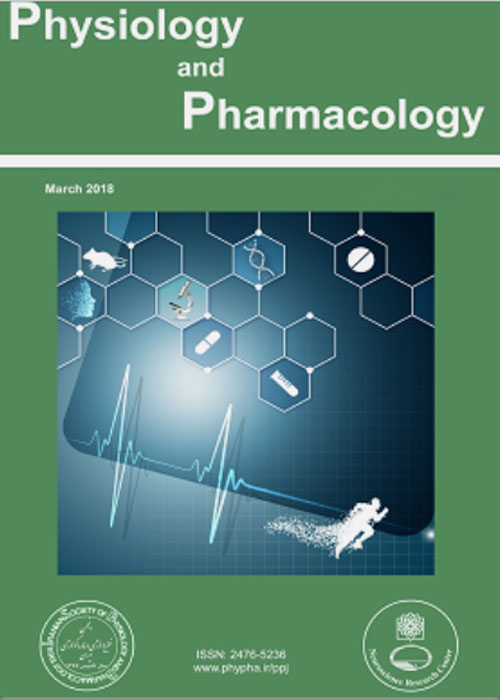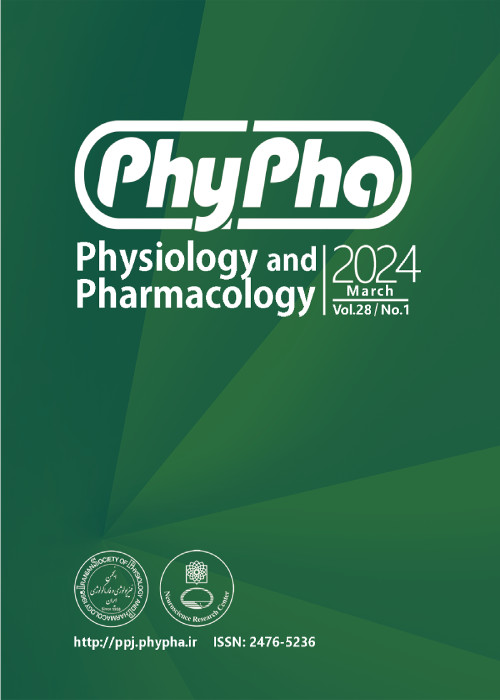فهرست مطالب

Physiology and Pharmacology
Volume:23 Issue: 2, June 2019
- تاریخ انتشار: 1398/04/24
- تعداد عناوین: 8
-
-
Pages 70-81IntroductionVarious pharmacological effects of Ocimum basilicum (O. basilicum) have been investigated including: antioxidant, antibacterial, anti-ulcerogenic, cardiac stimulant, hypoglycemic, hypolipidemic, hepatoprotective, anti-inflammatory, anticancer and immunomodulatory properties. It has also the beneficial effects in nervous system disorders, reproductive disorders and respiratory diseases. In this article the neuropharmacological effects of O. basilicum and its constituents is reviewed.MethodsThe data was gathered by searching: PubMed, Science Direct, Scopus and Google Scholar using the following key words: Basil, O. basilicum, neuropharmacological, neurotoxicity, neurodegeneration, memory, learning, epilepsy, pain, anticonvulsant, antianxiety, anxiety, depression and anti-depressant.ResultsThis review indicates that O. basilicum and its constituents have various properties including anti-depression, anti-anxiety, anti-analgesic, anti-nociceptive and memory enhancer which are probably due to its antioxidant property of O. basilicum.ConclusionIt seems that O. basilicum and its constituents could be of therapeutic values in nervous system diseases.Keywords: O. basilicum, Seizure, Depression, Anxiolytic, Analgesic
-
Pages 82-90IntroductionCobalamin (vitamin B12) is essential for metabolism of the nervous system and its supplementation attenuate neuropathic and neuroinflammatory diseases. We designed to investigate the neuroprotective effects of cobalamin against the trimethyltin chloride (TMT) induced structural and functional damages in the hippocampus.MethodsAdult male Wistar rats were divided into four groups: 1) control: received saline; 2) TMT: received a single dose of TMT (8mg/kg; ip) to induce hippocampal damages; 3) cobalamin: received cobalamin (18mg/kg; ip) for five consecutive days and 4) TMT+cobalamin: received single ip injection of TMT then were treated with cobalamin for five consecutive days. In day six of the experiments, behavioral effects of TMT and cobalamin were evaluated through shuttle box and novel object recognition task. After the behavioral tests, animals were perfused transcardially and Nissl staining was used on hippocampus to assess neural cell damages.ResultsNovel object exploring time was significantly decreased in TMT treated rats and treatment with cobalamin after TMT injection significantly recompensed this effect of TMT. In passive avoidance, TMT significantly decreased latency to enter the dark box, while cobalamin administration after the TMT injection significantly abolished this effect of TMT. Neural cell counted in the areas of hippocampus was significantly decreased in the TMT group and cobalamin treatment after the TMT injection significantly prevented neural cell loss.ConclusionThese results indicate a neuroprotective role for cobalamin against the TMT induced memory impairment and hippocampal neuronal loss.Keywords: Avoidance memory, Neurotoxin, Novel Object, Vitamin B12
-
Pages 91-100IntroductionAngiotensin converting enzyme (ACE) inhibitors are suggested to have some beneficial effects on the brain. In the present study the protective effects against brain tissues oxidative damage as possible mechanism for learning and memory improving effects of captopril was investigated in scopolamine treated rats.MethodsFifty male Wistar rats were divided into seven groups and treated: saline as a control group, Sco (scopolamine) and Sco-Capto10, 50 and 100 (captopril 10, 50 and 100mg/kg before scopolamine). Treatment was passive avoidance test and then the cortical tissues were collected to measure malondialdehyde (MDA), nitric oxide (NO) metabolites, thiol, super oxide dismutase (SOD) and catalase (CAT).ResultsScopolamine decreased the latency to enter the dark in passive avoidance test compared to control group. It also increased MDA and NO metabolites while decreased thiol, SOD and CAT in comparison with control group. Captopril increased the latency to enter the dark. It also decreased MDA and NO metabolites while, increased thiol, SOD and CAT.ConclusionCaptopril protected brain tissues oxidative damage and improved learning and memory impairment induced by scopolamine.Keywords: copolamine, Captopril, Oxidative stress, Learning, memory
-
Pages 101-114IntroductionThe basolateral amygdala (BLA) is implicated in stress-related disorders such as anxiety-like behavior. Substantial data exist demonstrating a close relationship between anxiety and adrenergic receptor function in patients with anxiety disorders; however, little is known about the effects of the β1 adrenergic receptor in the BLA on anxiety. This experiment examined the effects of the β1 adrenergic receptor in the BLA on anxiety-like behavior.MethodsMale Wistar rats were exposed to foot-shock stress four consecutive days that were uncontrollable. The β1-adrenoreceptor agonist (dobutamine; 0.5μl/side) or antagonist (atenolol; 0.25μl/side) bilaterally infused into the BLA five minutes before foot-shock stress. Anxiety-like behaviors were assessed 24h after four consecutive day’s uncontrollable stress using elevated plus-maze (EPM) and open field test (OFT).ResultsFindings of EPM revealed that foot-shock stress leads to anxiogenic effect with reduction the time spent and the number of entries into the open arms and increased head-dipping. Intra-BLA infusions of atenolol before stress affected animal behavior differently, such that it significantly increased the time spent and the number of entries into the open arms and decreased head-dipping. Also, OFT results showed the intra-BLA infusion of atenolol increased the time periods spent in the center, number of center entries and reduced the number of rearing as compared with the stress group.ConclusionThese results suggest that the anxiety-like behavior observed after the foot-shock stress is mediated, in part, by exaggerated β1 adrenergic receptor acting at the BLA.Keywords: Anxiety-like behaviour, Basolateral amygdala, β1-Adrenergic receptor, Stress
-
Pages 115-122IntroductionHuman neuroblastoma cell line is used in studying Parkinson’s disease (PD) due to its similarities to dopaminergic neurons. 6-hydroxydopamine (6-OHDA), a catecholaminergic neurotoxin, has been widely used to induce cell death in cellular models of PD. Although the brain glucose entry is not dependent on insulin, this peptide has been reported to have a role in PD, in which insulin signaling disruption is reported. This study aimed to evaluate, if insulin is efficient in preventing 6-OHDA induced cell death in human neuroblastoma cells as well as its effect on phoshorylated Akt (p-Akt)/total Akt (t-Akt) ratio.MethodsThe cells -grown in DMEM/F12 media supplemented with 10% fetal bovine serum- were exposed to 6-OHDA with/without insulin for 24h, and then MTT assay was done to examine their viability. A pilot study was performed to assess the protective doses of insulin and accordingly the doses 0.9 and 1mM were selected. Western blot assay was done to evaluate the effect of 6-OHDA or insulin on p-Akt and t-Akt level.ResultsThe results indicated that insulin has potency to prevent SH-SY5Y cell death, and p-Akt/t-Akt decline induced by 6-OHDA.ConclusionThe results suggested insulin as a protective agent in dopaminergic cells.Keywords: Insulin, Parkinson’s disease, 6-OHDA, SH-SY5Y, Akt
-
Pages 123-128IntroductionRenal ischemia/reperfusion (RIR) is considered as one of the most prevalent reasons of acute renal failure. As renal failure is progressed, renal gluconeogenesis and insulin clearance are decreased. Berberine is the most important alkaloid of Berberis vulgaris. It has anti-diabetic, anti-inflammatory and anti-microbial properties. The goal of this study was to assign the effect of RIR on the pancreas and to define the effect of berberine on the pancreatic damages induced by RIR.MethodsMale rats were allocated into four groups (n=7): sham (no intervention), Ber (berberine, 15mg/kg/day), I/R (subjected to 45min bilateral renal artery occlusion), Ber+I/R (berberine, 15mg/kg/day). After 24h, blood samples were collected for biochemical analysis and eventually pancreas tissue samples were kept for subsequent histological examination.ResultsThe ischemic challenge of kidneys resulted in pancreatic vascular congestion, which was associated with decreased plasma level of glucose as well as increased plasma insulin, creatinine and blood urea nitrogen levels at the termination of reperfusion period. In Ber+I/R group, pancreatic vascular congestion and decreased plasma level of insulin were improved concomitant to increase in plasma creatinine and urea nitrogen being smaller than those of the non-treated rats.ConclusionRIR injury has some roles in the development of tissue damages and probably functional disorders of the pancreas in rats. Furthermore, berberine has an ameliorative effect against organ injury induced by RIR in rat.Keywords: Renal ischemia, reperfusion, Berberine, Pancreas
-
Pages 129-139IntroductionPetroselinum crispum (P. crispum) is an associate of Umbelliferae family that has several therapeutic attributes. Ischemia/reperfusion (I/R) is one of the main challenges in acute kidney damage. This study was designed to assess the anti-inflammatory and protective effects of P. crispum extract against I/R-induced renal disorders.MethodsForty male rats were randomly divided into five groups (n=8) namely normal control (saline) and I/R control group, and three groups of I/R intraperitoneally pretreated with various doses of P. crispum (100, 150 and 200mg/kg). The I/R-induced renal inflammation was evaluated by determining leukocyte infiltration and mRNA expression level of intercellular adhesion molecule-1 and tumor necrotic factor-alpha. Antioxidant capacity of kidneys and thiobarbituric acid reactive species were measured in kidneys for the evaluation of oxidative stress. In addition, the diameters of renal glomeruli, kidney function indicators and serum nitrite oxide levels were respectively determined by morphometric analysis, autoanalyzer device and Griess technique.ResultsThe I/R increased all measured parameters except for the tissue ferric reducing/antioxidant power (FRAP) level, which was decreased compared to the normal control group. However, pretreatment with P. crispum extract in all doses significantly reduced blood urea nitrogen, kidney malondialdehyde, creatinine, glomerular diameter, leukocyte infiltration, levels of tumor necrotic factor-alpha, adhesion molecule-1 expression, and nitrite oxide as well as increased tissue FRAP compared to the I/R control group.ConclusionIt seems that P. crispum administration improves I/R-induced acute kidney injury.Keywords: Petroselinum crispum, Injury, Kidney
-
Pages 140-149IntroductionThis study was designed to evaluate the effects of cinnamon extract on ulcerative colitis in rats.MethodsThirty-two male Wistar rats were divided into four groups: untreated control, positive control group (acetic acid-induced ulcerative colitis), cinnamon extract treated group (150mg/kg/day) and treated group with prednisolone (4mg/kg/day). After 10 consecutive days, the rats were euthanized and examined for the production of inflammatory mediators and oxidative stress indices in the intestinal tissue.ResultsData showed that both therapies could reduce the cumulative disease score. The results also indicated that treatment with cinnamon caused a more benefit in restoring the total antioxidant capacity of the colonic specimens of the colitis-induced rats compared to treatment with prednisolone. The levels of myeloperoxidase and nitric oxide were down-regulated in the colons of cinnamon treated rats more than prednisolone groups. Prednisolone significantly decreased the levels of TNF-α and IL-6 cytokines more than colitis rats treated with cinnamon extract. The levels of COX-2 were decreased and conversely, the total protein content of colonic homogenates was increased in the colons of both treatment groups in a non-significant manner, compared to untreated colitis rats.ConclusionThese results demonstrated cinnamon as herbal medicine is a promising strategy to improve the inflammation in a rat model of ulcerative colitis. It is logical to consider some of the beneficial effects of cinnamon extract associated with its direct antioxidant benefits, along with its direct anti-inflammatory benefits.Keywords: Ulcerative colitis, Cinnamon extract, Inflammation


